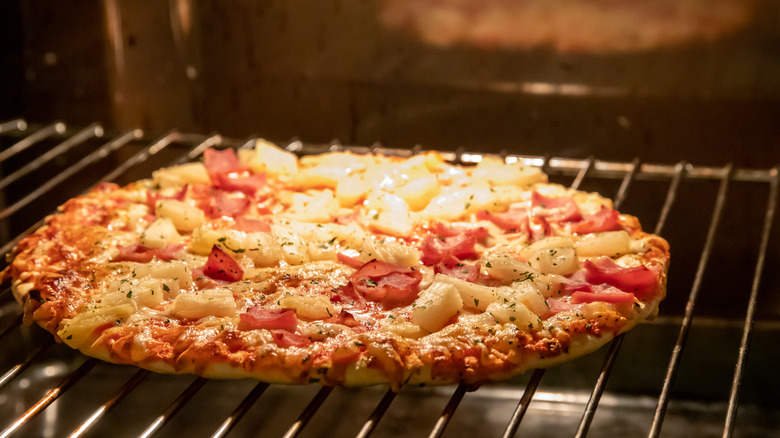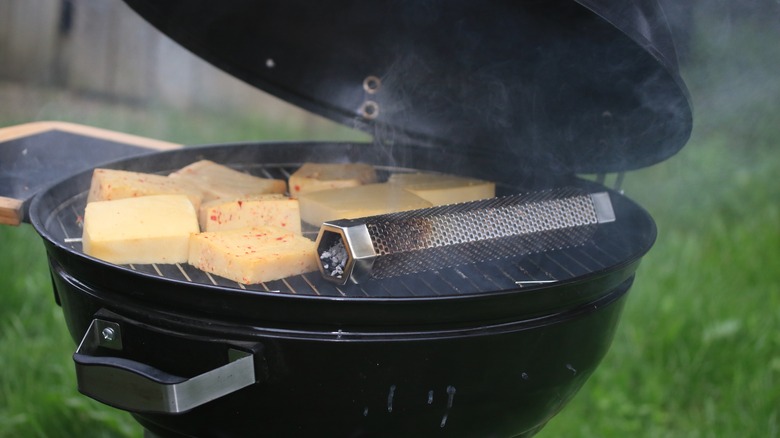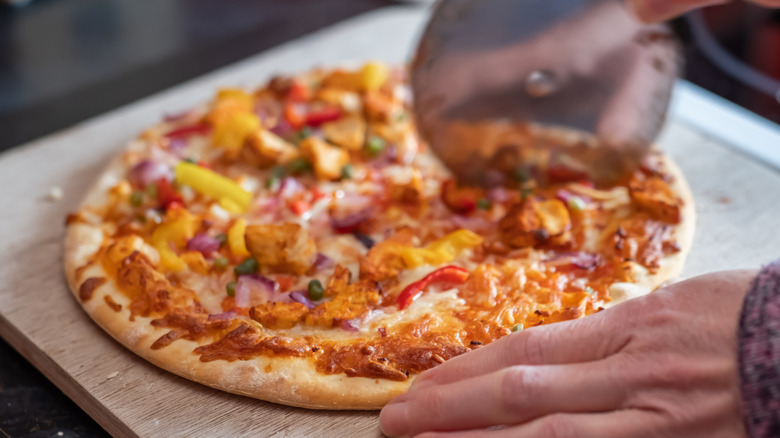For Extra Char Flavor, Try Cooking Frozen Pizza In The Smoker
A frozen pizza has its benefits, to be sure. But, let's be honest here: Frozen pizza isn't the same as the pizza you get from an actual pizzeria. If you go to a place that serves wood-fired pizza, for instance, you'd find that it's probably leaps and bounds better than the box of frozen pepperoni pizza crammed in your freezer. This isn't to say that all frozen pizzas are bad, of course, but it's like comparing McDonald's to a gourmet restaurant: pretty good, but not the same quality.
There are, however, ways that you can make your frozen pizza taste just as good as the fresh stuff you get at a pizzeria. If you want your pizza to taste more like an actual pizza than some frozen cheese topped on a cardboard-flavored crust, Pizza Bien suggests not only adding a handful of fresh shredded cheese and your own toppings to the pizza, but also hitting the crust with a quick brush of olive oil and parmesan cheese before baking it. If you want the pizza to have that trademark crispy pizzeria crust, Cooking Light recommends cooking the pizza on the highest possible setting that your oven can go for a few minutes — although this may be more for veteran pizza bakers, as the high temperature may result in a burned pizza if not watched carefully.
If you're looking for that classic "charred crust" taste, however, you may want to skip the oven entirely and bust out the smoker.
Use a smoker for that smokey, woody flavor in your frozen pizza
When you think of a smoker, you most likely think of smoking poultry or fish, not frozen pizza. But it seems that using the smoker for this unusual purpose may give your pizza that smokey, woody taste, you expect to find at a pizzeria.
As Real Simple explains, the main benefit of the smoker is that it uses wood or wood pellets, which can impart different flavors and aromas onto whatever is inside it. If you would want a smokier type of pizza, you can add hickory wood or mesquite wood, If you're looking for a slightly sweet flavor that's more reminiscent of a barbeque, MasterClass suggests adding woods such as oak, maple, or pecan wood. Another benefit of using the smoker is that, unlike grills or ovens, the pizza is cooked through indirect heat rather than being laid on a hot pan or a rack. This means you don't have to worry about burning the crust as much as you would if you put the pizza in the oven.
But how do you even use a smoker with a frozen pizza to begin with? If the advice given by BBQ Hero is to be believed, it's actually pretty simple. Preheat your smoker to 250 degrees Fahrenheit with a pizza stone in it, and then cook the pizza for 15 minutes at that temperature. After 15 minutes, just increase the temperature to 300 degrees and cook the pizza for another 10 minutes to finish cooking it.
What if you don't have a smoker?
Whatever the reason is, be it lack of space or lack of money, you don't have a smoker. But, you do have an oven and maybe a regular backyard grill. How can you get that classic wood-fired char taste on your frozen pizza without using a smoker?
If you have a grill, Lifehacker says that grilling your pizza not only produces a better browning and a charred flavor than the oven, but it's also somewhat faster too. The crust gets a golden-brown crispness to it, alongside those noticeable char spots, and the toppings — especially meat toppings — get that delicious smokey flavor. Although a charcoal grill may be more useful if you want that "traditional" grilling flavor, a propane grill is also said to work perfectly fine. Lifehacker does suggest, though, that you avoid using pizzas with thick crusts and use cheaper, thinner crust pizzas for the best results.
If you just have a plain old oven, Insider gives a few useful tips on how to get the most out of it. One trick is to place the pizza directly on the oven rack rather than a pan or sheet, thus exposing the pizza to as much heat from the bottom as possible. You can also use extras such as garlic butter, lemon juice, or fresh vegetables to add more flavor to the pizza, which can help compensate for the lack of coal or wood pellets for that extra flavor.


